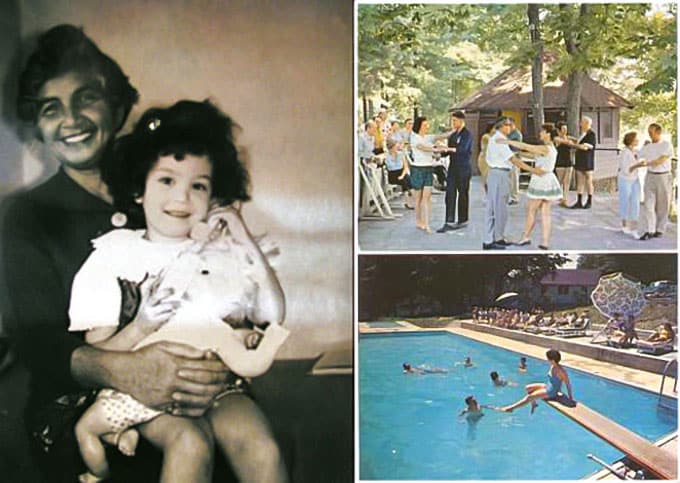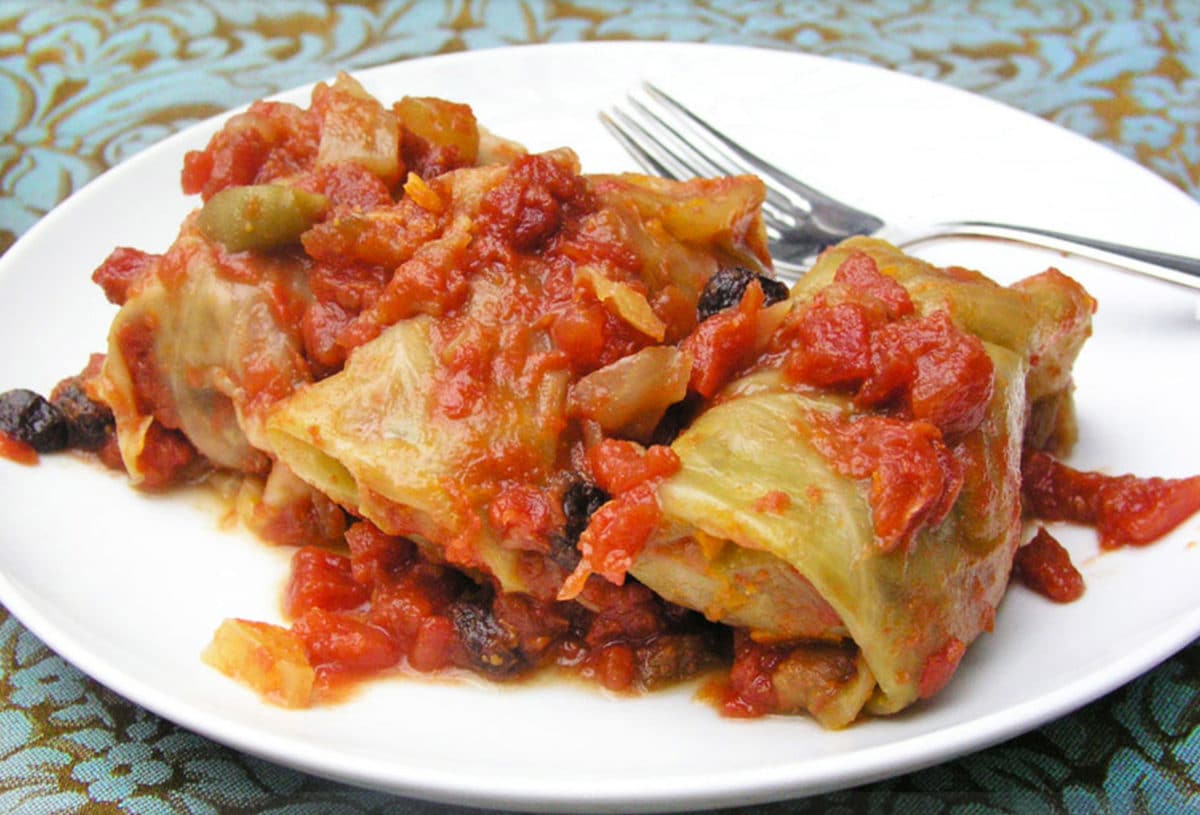Every summer one of my parents drove with me for two hours, from Manhattan to the Catskill Mountains, to spend a week at my grandparents’ hotel, Sunny Oaks. At that time (the 1960s and 70s) the Catskills was the hot summer vacation destination for New York City Jews. Sunny Oaks was one of many resorts in the area that were owned and run by Jewish immigrants from Eastern Europe. My grandmother’s family came from Belarus at the turn of the century. They bought property in the Catskills in 1928 with dreams of farming the land. The farm morphed into a boarding house and then a hotel. Sunny Oaks wasn’t fancy. Guest cottages were small, with mismatched furniture. There was one phone for all of the one hundred people, one television, and many guests shared a bathroom. People loved Sunny Oaks for the warm hospitality and wholesome good food.
The Sunny Oaks menu was built on recipes from the old country – simple roast chicken, boiled beef flanken, cheese blintzes – recipes passed down from my great-grandmother Ida to her daughters Rose, Hannah and Fay. My favorite food at Sunny Oaks, and in the whole world, was my Grandma Fay’s Russian stuffed cabbage – ground beef, rice and onions, rolled up in cabbage leaves, smothered with sweet and sour tomato sauce, and baked for hours until tender and infused with flavor. Stuffed cabbage was a laborious dish to prepare. It wasn’t on the daily hotel menu, yet my Grandma Fay always had some stowed away for me when I visited.
“Are we there yet?” I’d keep asking. The two-hour car ride felt like it lasted forever. Finally we would get off the highway and onto the quiet hilly roads of Fallsburg, which would lead to the tiny village of Woodridge. Only one more mile and I would see the familiar little lake and the sign “Welcome To Sunny Oaks.” As we neared the top of the steep driveway, the front porch of the hotel would come into view. There were always a couple of guests sitting outside, reading the newspaper or knitting, enjoying the fresh mountain air. We would pull into a parking spot behind the kitchen, get out of the car, and walk around to the front. I knew as soon as I was spotted, the serenity would be broken. Someone would yell, “Lisa’s here!” Someone else would run to find my grandmother. I would brace myself for an onslaught of cheek squeezes, hugs and comments, half in Yiddish, about how much I’d grown. My grandmother’s hello was enormous, with a big red lipstick kiss on my cheek. Then we would head straight for the dining room.

There was no discussion of whether I was hungry or not. She would sit me down at a table in the empty dining room and bring me a big plate of stuffed cabbage. The first thing I did was rip off all the cabbage leaves and discard them to the side of my plate. (I hated vegetables.) Then I would dig into my favorite food in the world. Grandma Fay would sit beside me and, not wanting anything to go to waste, she ate everything on my plate that I pushed aside. It was our yearly ritual and the only time I can remember my grandmother ever sitting down. She was busy, energetic and unstoppable. But watching me, her much-too-skinny, picky-eater granddaughter, wolf down a big plate of hearty Jewish home cooked food, was a compelling enough reason to sit still for a few minutes, even for my frenetic Grandma Fay.
The Jewish-food-centric Catskills came to be known as The Borscht Belt. Borscht is a quintessential Eastern European dish. I’m sure borscht was on the menu at every Catskills resort. At Sunny Oaks it was offered every day, at lunch and dinner. I can still picture the white porcelain bowls with beet discs and slices of onion sloshing around in reddish-purple broth. Borscht was one of the Sunny Oaks dishes that looked gross and inedible to me, along with kippered herring, beef tongue Polonaise, liver and onions, and vegetables.
Kids were in the minority in the Sunny Oaks dining room. We were surrounded by Jewish grandmothers who defined us as either “good eaters” or “bad eaters.” I fell into the second category, and everyone had something to say about it. “She’s such a string bean!” “She needs some meat on her bones!” “What? She doesn’t eat vegetables? Oy!”
I was not the only fussy eater in the dining room. Everyone had particular likes, dislikes, food sensitivities, and special requests. My grandmother made sure everyone got their meal exactly the way they wanted it. Her perpetual mission to make everyone happy – especially when it came to food – is why the hotel guests became her close friends and why the same people came back to Sunny Oaks summer after summer for over 60 years.
Through little girl eyes, Sunny Oaks was a place where ‘old people’ fussed over me, worried about me, and adored me. Their offhand remarks about my being too thin or too picky felt well intentioned in the setting of Sunny Oaks. It also helped that my grandmother was always there to say, “Leave her alone. She’s fine!” The Sunny Oaks crowd was an uninhibited, opinionated bunch. They were in the Catskills to let loose and have a blast. They played Scrabble and bridge, they folk danced, they crooned and told jokes and put on silly skits at the Saturday night talent show. And they spoke their own special language, English spiced with Yiddish: “I’m kvelling,” “He’s such a mensch,” “Everything will be fine, kine-ahora.”
When kids visited Sunny Oaks, we learned the joys of dancing, playing board games, and shuffleboard. Otherwise we were in the pool, swimming and doing handstands in the ice-cold water until we were blue. Or we took walks on the quiet country roads, searching for wild orange touch-me-nots so we could squeeze their pods and make them explode. Over the years my interests evolved from swimming and shuffleboard to flirting with the waiters and hoping someone’s cute grandson might be visiting that weekend.
Throughout all the years that I feasted on Fay’s stuffed cabbage, I never gave a thought to how it was made. I remember the moment I realized that Fay must work really hard to cook for everyone. I was visiting her at her winter home in Florida. We were standing in the kitchen. She was planning for New Year’s. Fay always hosted a big New Year’s Eve party for a hundred of her Florida friends. She was half talking to herself and half to me, saying that this is the last year she’d be making a hundred stuffed cabbages for New Year’s Eve, that it might even be the last year she’d host the party. But she didn’t follow through on that. Cooking for her friends and hosting them on New Year’s Eve was a labor of love that Fay never gave up. Grandma Fay passed away when I was 30. I had never cooked with her or asked for her recipes. What I wouldn’t give now to travel back in time and trade some of those endless hours in the swimming pool for time in the kitchen with Fay.
Eventually business slowed down at Sunny Oaks as the devoted clientele aged and passed away. The Catskills lost its appeal to New Yorkers, as air travel became more affordable and better highways were built. Today the big Jewish resorts are gone. Orthodox Jews and Hasidim have repopulated the area and built their summer homes where the resorts used to be.
My Aunt Cynthia and Uncle Ted ran the hotel in the later years. When it shut down completely in 1999, they renovated the property and converted the old social hall into a summer home overlooking the lake. It’s not the place I once knew and loved. But the old Sunny Oaks is still alive in my memories. I remember an especially great weekend in the summer of 1983. My grandmother’s best friend Eva was there that weekend with her four adorable grandsons. One of them was Eddie Goldfinger. Seven years later I married Eddie.
A few years ago, after I started my food blog Panning The Globe, I called my Aunt Cynthia to see if she remembered any of the old recipes from the hotel. She dug up a folder with a thick stack of my grandmother’s recipes, hand-typed by my grandfather. I now cook Fay’s recipes. And I have inherited her need to make people happy with food, and her commitment to hosting the neighborhood New Year’s Eve party.
My Grandmother Fay Levinson’s Original Stuffed Cabbage Recipe, as Written:
Cook separated cabbage leaves until parboiled. Trim for rolling.
To chopped beef, add chopped celery, onion, green pepper and one egg, approximately for each lb of beef…perhaps less.
Add to this about 1 cup of raw rice for each 5 lbs of beef. Mix well. Form into balls. Roll into cabbage rolls, and lay these on a bed of vegetables in a flat deep pan. Bed to consist of cabbage cores chopped, onions and celery chopped.
For 165 portions; make broth using 1 1/2 lb brown sugar, 8 cans 2 1/2 lb whole tomatoes crushed by hand, 1 tsp sour salt.
Add water to cover the cabbage rolls and cook for 1 hour.
Then uncover, and skim fat off top. Drain a substantial amount of the liquid and thicken with cornstarch and pour over cabbage rolls.
Let cook another 2 hours at about 375 until done.
Can be reheated and is even more tasty when reheated. ![]()
